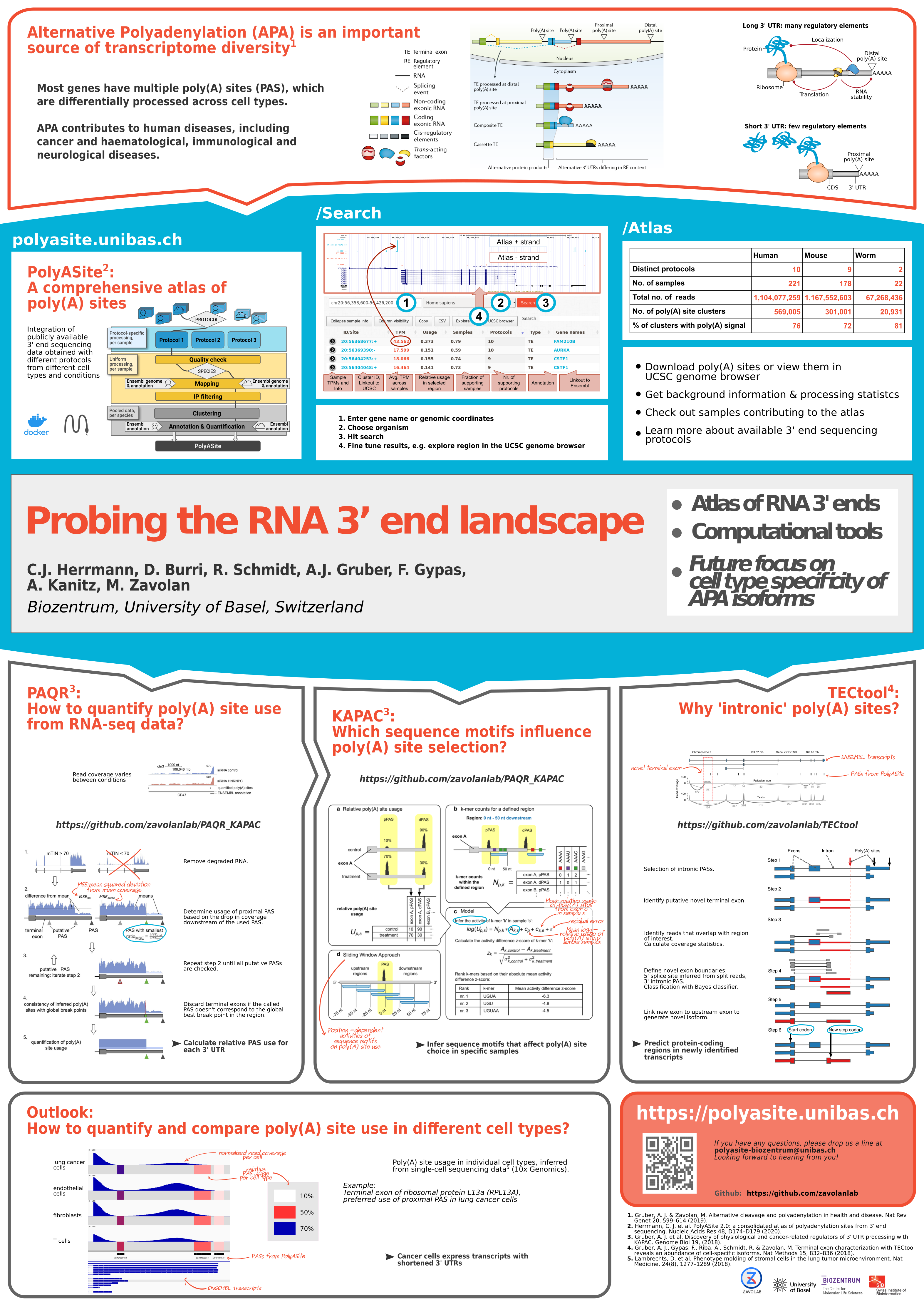News & Publications
Learn more on how PolyASite has been used by us and others.
RNA2020 Online: Award winning poster

Publications citing PolyASite
Li, G. et al. SCAPTURE: a deep learning-embedded pipeline that captures polyadenylation information from 3'tag-based RNA-seq of single cells. bioRxiv (2021)

Bai, Y. et al. Cell-type-specific alternative polyadenylation (APA) genes reveal the function of dynamic APA in complex tissues. bioRxiv (2020)

Bai, Y. et al. Identifying genes with cell-type-specific alternative polyadenylation in multi-cluster single-cell transcriptomics data. bioRxiv (2020)

Bhat, P. et al. Systematic refinement of gene annotations by parsing mRNA 3' end sequencing datasets. (2021)

Mulroney, L. Identification of Full-Length Transcript Isoforms Using Nanopore Sequencing of Individual RNA Strands. (2020)

Fiszbein, A. et al. Widespread occurrence of hybrid internal-terminal exons in human transcriptomes. bioRxiv (2021)

Agarwal, V. et al. The landscape of alternative polyadenylation in single cells of the developing mouse embryo. bioRxiv (2021)

Gerber, S. et al. Streamlining differential exon and 3' UTR usage with diffUTR. BMC bioinformatics (2021)

Raguz, N. et al. JMJD6 regulates splicing of its own gene resulting in alternatively spliced isoforms with different nuclear targets. International journal of molecular sciences (2020)

Jalihal, A. et al. Multivalent proteins rapidly and reversibly phase-separate upon osmotic cell volume change. Molecular cell (2020)

Jin, W. et al. Animal-APAdb: a comprehensive animal alternative polyadenylation database. Nucleic Acids Research (2021)

Joglekar, A. et al. Cell-type, single-cell, and spatial signatures of brain-region specific splicing in postnatal development. BioRxiv (2020)

Joglekar, A. et al. A spatially resolved brain region-and cell type-specific isoform atlas of the postnatal mouse brain. Nature Communications (2021)

Kandhari, N. et al. The Detection and Bioinformatic Analysis of Alternative 3' UTR Isoforms as Potential Cancer Biomarkers. International Journal of Molecular Sciences (2021)

Marini, F. et al. TREND-DB a transcriptome-wide atlas of the dynamic landscape of alternative polyadenylation. Nucleic Acids Research (2021)

Mitschka, S. et al. Generation of 3' UTR knockout cell lines by CRISPR/Cas9-mediated genome editing. (2021)

Mulroney, L. et al. Identification of high confidence human poly (A) RNA isoform scaffolds using nanopore sequencing. bioRxiv (2020)

Pereira-Castro, I. and Moreira, A. On the function and relevance of alternative 3'-UTRs in gene expression regulation. Wiley Interdisciplinary Reviews: RNA (2021)

Peros, I. et al. Advances in the Bioinformatics Knowledge of mRNA Polyadenylation in Baculovirus Genes. Viruses (2020)

Pritts, J. et al. Understanding RNA Binding by the Nonclassical Zinc Finger Protein CPSF30, a Key Factor in Polyadenylation during Pre-mRNA Processing. Biochemistry (2021)

Sena, R. et al. The RNA-Binding Protein HuD Regulates Alternative Splicing and Alternative Polyadenylation in the Mouse Neocortex. Molecules (2021)

Sethi, S. et al. Leveraging omic features with F3UTER enables identification of unannotated 3'UTRs for synaptic genes. bioRxiv (2021)

Shin, J. et al. Modulation of alternative cleavage and polyadenylation events by dCas9-mediated CRISPRpas. (2021)

Swamy, V. et al. A long read optimized de novo transcriptome pipeline reveals novel ocular developmentally regulated gene isoforms and disease targets. bioRxiv (2020)

Swamy, V. et al. A short-read de novo transcriptome construction pipeline optimized by long reads reveals novel developmentally regulated gene isoforms and disease targets in hundreds of eye samples. bioRxiv (2020)

Lusk, R. et al. Aptardi predicts polyadenylation sites in sample-specific transcriptomes using high-throughput RNA sequencing and DNA sequence. Nature communications (2021)

Luzzi, S. et al. RBMX enables productive RNA processing of ultra-long exons important for genome stability. bioRxiv (2020)

Wilton, J. et al. Simultaneous studies of gene expression and alternative polyadenylation in primary human immune cells. (2021)


